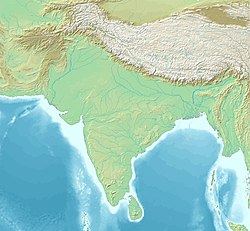Amb Temples
 The site consists of the ruins of two Hindu temples located in Pakistan's Salt Range mountains | |
| Location | Khushab District, Punjab, Pakistan |
|---|---|
| Region | Salt Range mountains |
| Coordinates | 32°30′30″N 71°56′12″E / 32.508402°N 71.936538°E |
| Type | Temple complex |
| History | |
| Founded | 9-10th century CE.[1] |
| Periods | Hindu Shahi |
| Cultures | Punjabi Hindu |
The Amb Temples (Urdu: امب مندر), locally known as Amb Sharif (Urdu: امب شریف; "Noble Amb"), are part of an abandoned Hindu temple complex on the Sakesar mountain, located at the western edge of the Salt Range in Pakistan's Punjab province.[2] Although foundations go back to the period of Kushan Empire, the temple complex was built in the 9th to 10th centuries CE during the reign of the Hindu Shahi empire.[1][3]
Location
[edit]The ruins are located near Amb Sharef village, on Sakesar mountain in the Soon Valley of Pakistan. The ruins form the westernmost ruins of a string of Hindu temples in the Salt Range mountains that includes the Katas Raj Temples and Tilla Jogian monastic complex.
Architecture
[edit]The main temple is roughly 15 to 20 metres tall, and built out of brick and mortar on a square plinth. It is regarded as the "loftiest" of temples built by the Hindu Shahi empire.[4] The temple ruins have three stories, with stairwells leading to inner ambulatories.[5]
The temple is decorated with Kashmiri style motifs on its exterior, including a cusped niche.[5] The structure of the main temple, differs from Kashmiri temples which typically have pointed tops.[5] The main temple is instead similar in style to the nearby Kalar temple, and Kafir Kot temple in Khyber Pakhtunkhwa province.[6]
To the west about 75 metres lies another smaller temple, which is 2 story or 7 to 8 meters high,[7] situated near a cliff. The temple features a small vestibule chamber facing towards the main temple. It was a few metres from a second similarly sized temple, which no longer exists.[5] The entire temple complex was surrounded by a fortification, with the earliest construction at the site dating to the late Kushan period.[5]
Conservation
[edit]The site was visited by Alexander Cunningham in the late 19th century, and was partly conserved in 1922-24 by Daya Ram Sahni.[5] The temple had been looted over the centuries. The last remaining statuary was taken in the late 19th century and placed in the Lahore Museum.[5] The site is currently protected by Pakistan's Antiquities Act (1975).
Gallery
[edit]-
The main temple
-
The main temple features a Kashmiri-style cusped archway
-
A view of the smaller temple with its vestibule chamber
-
The base of the main temple
-
A view of the main temple's plinth
See also
[edit]References
[edit]- ^ a b Meister, Michael W. (26 July 2010). Temples of the Indus: Studies in the Hindu Architecture of Ancient Pakistan. BRILL. pp. 29–31. ISBN 978-90-04-19011-5.
- ^ "The forgotten temples | Footloose". The News International.
- ^ Gazetteer of the Attock District, 1930, Part 1. Sang-e-Meel Publications. 1932. Retrieved 21 September 2017.
- ^ Rashid, Salman (2001). The Salt Range and the Potohar Plateau. Sang-e-Meel Publications. ISBN 9789693512571. Retrieved 21 September 2017.
- ^ a b c d e f g Meister, Michael (2005). "Fig Gardens of Amb-Sharif, Folklore and Archaeology". East and West. 55 (1/4). Istituto Italiano per l'Africa e l'Oriente: 201–216. JSTOR 29757645.
- ^ Journal of the Royal Asiatic Society of Great Britain and Ireland. Cambridge University Press for the Royal Asiatic Society. 1903. Retrieved 21 September 2017.
- ^ Amir, Tariq (12 May 2014). "Pakistan Geotagging: Hindu Temple At Amb".








